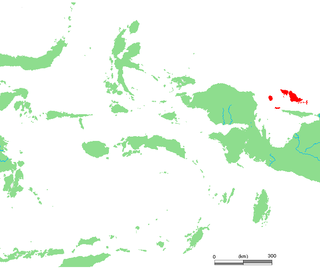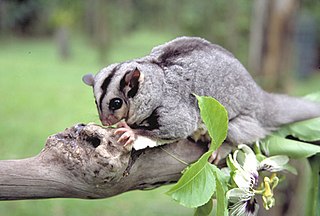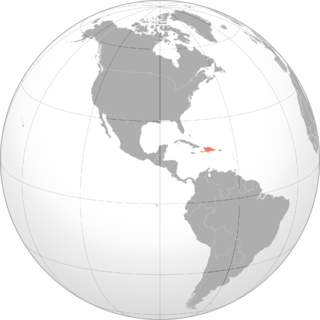
The sugar glider is a small, omnivorous, arboreal, and nocturnal gliding possum belonging to the marsupial infraclass. The common name refers to its predilection for sugary foods such as sap and nectar and its ability to glide through the air, much like a flying squirrel. They have very similar habits and appearance to the flying squirrel, despite not being closely related—an example of convergent evolution. The scientific name, Petaurus breviceps, translates from Latin as "short-headed rope-dancer", a reference to their canopy acrobatics.

Phalangeriformes is a paraphyletic suborder of about 70 species of small to medium-sized arboreal marsupials native to Australia, New Guinea, and Sulawesi. The species are commonly known as possums, gliders, and cuscus. The common name "possum" for various Phalangeriformes species derives from the creatures' resemblance to the opossums of the Americas. However, although opossums are also marsupials, Australasian possums are more closely related to other Australasian marsupials such as kangaroos.

Petauridae is a family of possums containing 11 species: four species of trioks and striped possum, six species of wrist-winged glider, and Leadbeater's possum, which has only vestigial gliding membranes. Most of the wrist-winged gliders are native to Australia, whereas most of the striped possums to New Guinea, but some members of each group are found on both sides of the Torres Strait. Leadbeater's possum is endemic to Victoria, Australia.

The squirrel glider is a nocturnal gliding possum. The squirrel glider is one of the wrist-winged gliders of the genus Petaurus.

The Schouten Islands are an island group of Papua province, eastern Indonesia in the Cenderawasih Bay 50 km off the north-western coast of the island of New Guinea. The group consists of the main islands of Biak, Supiori and Numfor, and numerous smaller islands, mostly covered in rain forest.

The genus Petaurus contains flying phalangers or wrist-winged gliders, a group of arboreal possums native to Australia, New Guinea, and surrounding islands. There are eight species: the sugar glider, savanna glider, Krefft's glider, squirrel glider, mahogany glider, northern glider, yellow-bellied glider and Biak glider.

The Townsend's mole is a fossorial mammal in the family Talpidae, and is the largest North American mole. It was named after the American naturalist John Kirk Townsend. The name was selected at the request of Thomas Nuttall as a patronym to honor Townsend's contribution.
There are many different types of gliding possum, sometimes referred to as volplane possum, flying phalangers, or simply as gliders:

The mahogany glider is an endangered gliding possum native to a small region of coastal Queensland in Australia.

The yellow-bellied glider, also known as the fluffy glider, is an arboreal and nocturnal gliding possum that lives in native eucalypt forests in eastern Australia, from northern Queensland south to Victoria.

The lemuroid ringtail possum, also known as the lemur-like ringtail possum or the brushy-tailed ringtail, is a truly singular member of the ringtail possum group. It was once thought that they were gliding possums ; Hemibelideus literally translates as "half-glider". They are similar to lemurs in their facial characteristics, with short snouts, large, forward-facing eyes and small ears, but similar to gliders in their musculo-skeletal adaptations to accommodate a leaping lifestyle. Their long, prehensile tail is a further adaptation to their arboreal habitat.
The Mahomet mouse is a species of rodent in the family Muridae. It is found in Ethiopia, Kenya, and Uganda. Its natural habitats are subtropical or tropical moist montane forests and subtropical or tropical high-altitude shrubland. It is threatened by habitat loss.
The Japen rat is a species of rodent in the family Muridae found only in Yapen, Biak-Supiori, and Owi islands of West Papua, Indonesia.

The northern glider is a species of marsupial in the family Petauridae. It is endemic to Papua New Guinea, becoming known to science in 1981 after being discovered in the Torricelli Mountains. This species has been found in primary, mid-montane tropical moist forests. It is also known from rural gardens close to forest. The northern glider is Critically Endangered because its occurrence is less than 100 km2, all individuals are located within a single area, and a continuing decline of its habitat quality due to deforestation and human encroachment. They also face a major threat from hunting.

The northern common cuscus, also known as the gray cuscus, is a species of marsupial in the family Phalangeridae native to northern New Guinea and adjacent smaller islands, but is now also found in the Bismarck Archipelago, southeast and central Moluccas, the Solomons, and Timor, where it is believed to have been introduced in prehistoric times from New Guinea. It was formerly considered conspecific with the allopatric P. intercastellanus and P. mimicus.

Thomas's fruit-eating bat, sometimes also popularly called Watson's fruit-eating bat, is a species of bat in the family Phyllostomidae. It is found from southern Mexico, through Central America to Colombia. Its South American range is to the west of the Andes. The species name is in honor of H. J. Watson, a plantation owner in western Panama who used to send specimens to the British Natural History Museum, where Oldfield Thomas would often describe them.

Petauroidea is a superfamily of marsupials from Australia and New Guinea. It is part of the suborder Phalangeriformes within the order Diprotodontia, which also includes, among others, wombats, kangaroos, cuscuses. The superfamily Phalangeroidea, including cuscuses and brushtail possums and pygmy possums, is the immediate sister group of the Petauroidea.
The Biak Island uromys or Biak giant rat is a species of rodent in the family Muridae. It is known only from a single specimen collected on the Indonesian island of Biak.

The Hispaniolan greater funnel-eared bat is a funnel-eared bat species endemic to the island of Hispaniola in the Caribbean. First described in 1902, it has a complex taxonomic history, with some authors identifying multiple subspecies, now recognised as the separate species Natalus primus and Natalus jamaicensis, and others considering Natalus major to be itself a subspecies of Natalus stramineus. It lives primarily in caves and feeds on insects.















